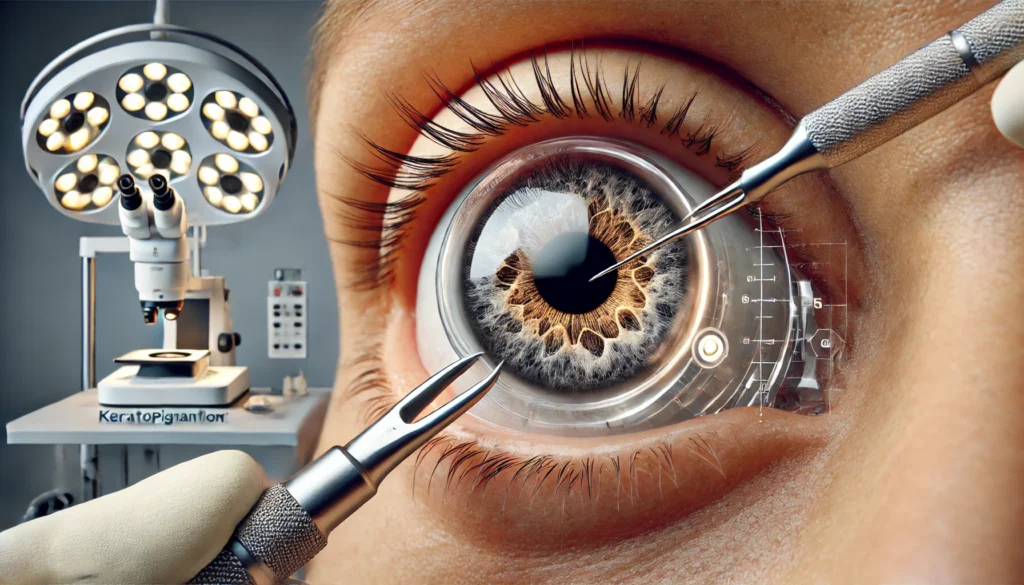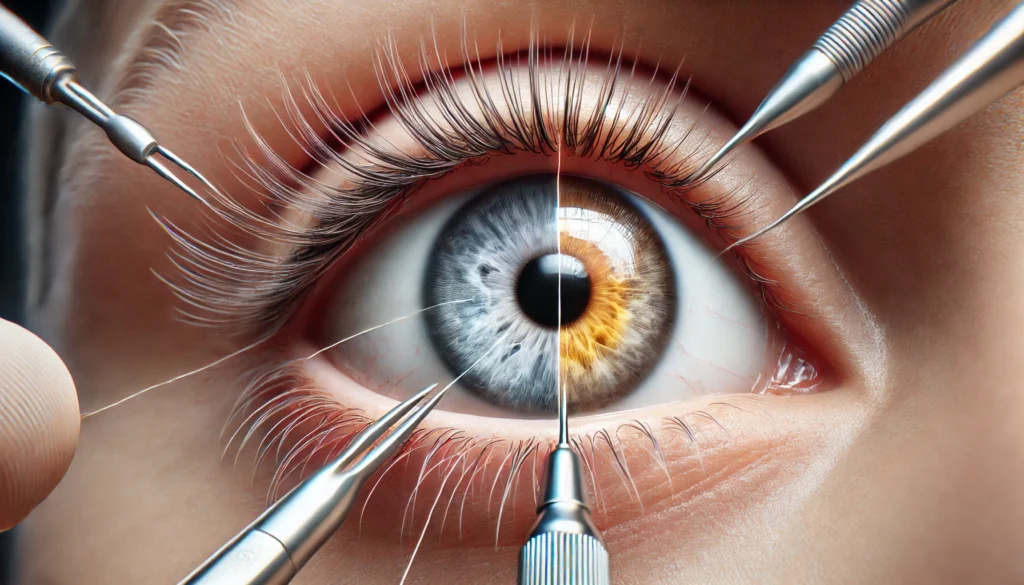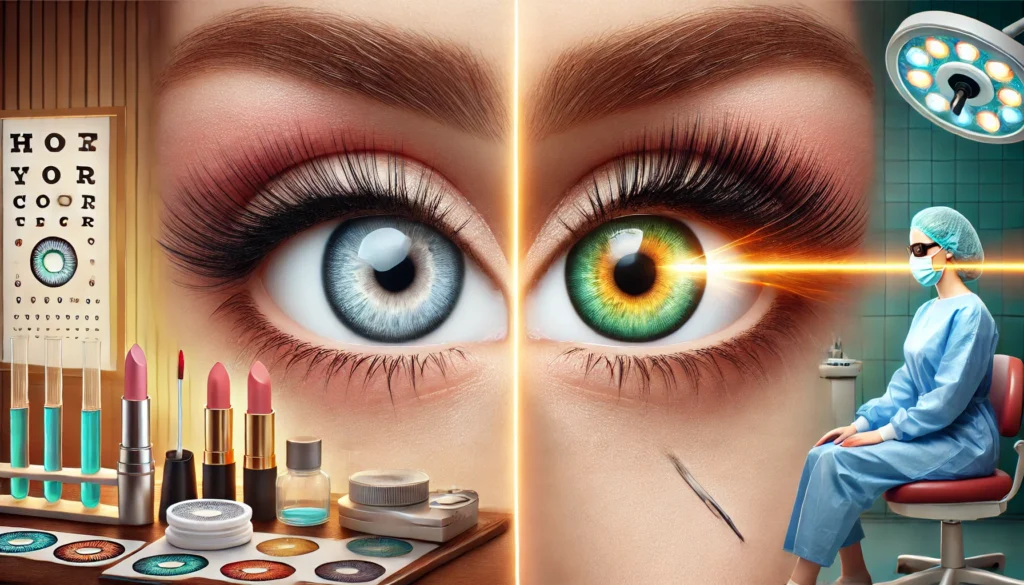Daniela Requena and Eye Color Change Surgery: What You Must Know About Keratopigmentation

- Who Is Daniela Requena?
- What Is Keratopigmentation (Corneal Tattooing)?
- Why Are People Choosing to Change Their Eye Color Permanently?
- The Risks: What Experts Are Saying
- Daniela Requena's Experience: From Satisfaction to Second Thoughts
- Thinking About Changing Your Eye Color? Here’s Our Professional Advice
- Conclusion: Beauty, But at What Cost?
- FAQ: Daniela Requena & Keratopigmentation — Eye Color Tattoo Surgery Explained
Have you ever imagined having bright blue or green eyes instead of brown? Spanish influencer and journalist Daniela Requena made that dream a reality in March 2023 through a controversial procedure called keratopigmentation, also known as corneal tattooing.
While the idea may sound appealing, there’s much more beneath the surface—and we’re here to break it down for you with clarity, accuracy, and empathy.
Who Is Daniela Requena?

Daniela Requena is a well-known Spanish journalist and LGBTQ+ advocate. She became a public figure thanks to her honest storytelling, activism for trans rights, and appearances on shows like Espejo Público and Telecinco. In 2023, she captured headlines across Spain and Latin America for undergoing an eye color change surgery from brown to a stunning blue-green shade.
Her transparency in documenting her surgery journey on TikTok made her a viral sensation—but also sparked a storm of controversy among eye care professionals.
What Is Keratopigmentation (Corneal Tattooing)?
Keratopigmentation is a medical and cosmetic procedure that involves inserting pigment into the cornea (the eye's transparent outer layer) to permanently change its color. Unlike iris implants or laser depigmentation, keratopigmentation doesn't involve direct modification of the iris, making it technically less invasive—but not risk-free.

How Does It Work?
The process involves:
- Creating a micro-tunnel in the cornea using a femtosecond laser
- Injecting biocompatible pigment (usually mineral-based)
- The color remains trapped in the corneal tissue
According to Daniela, the procedure:
- Took about 45 minutes
- Was done under local anesthesia (eye drops)
- Required only a few days for initial recovery
"It didn't hurt at all, just felt a little irritation afterward," Daniela said in her TikTok video.
Is It Safe?
Here’s where it gets complicated. While the technique has medical applications (for patients with trauma or eye conditions like aniridia or leukoma), cosmetic use is highly controversial. Pigments used in the procedure are not approved for intraocular use in many countries, including the U.S.
Why Are People Choosing to Change Their Eye Color Permanently?

The Desire for a New Look (And Identity)
We get it—your eyes are one of the first things people notice. Changing eye color can dramatically impact your appearance, and for many people, it’s tied to identity expression, especially for those in the LGBTQ+ community or who have faced gender dysphoria.
In Daniela’s case, she expressed that having blue eyes was part of her feminine identity. Her words, "Ahora tengo los ojos que siempre quise," reflect a deep emotional satisfaction.
Comparison of Options: What's Out There?
| Method | Description | Pros | Cons |
|---|---|---|---|
| Colored Contact Lenses | Non-surgical, temporary | Safe, affordable | Daily use, discomfort, hygiene issues |
| Laser Depigmentation | Laser removes melanin from the iris | Natural tone revealed | High glaucoma risk, not FDA approved |
| Iris Implants | Artificial iris placed over natural one | Permanent change | Very invasive, many banned due to complications |
| Keratopigmentation | Pigment inserted in the cornea | Quick recovery, permanent color | Not FDA approved, risk of complications |
Takeaway: Keratopigmentation offers a permanent solution with faster recovery, but the long-term safety data is still limited.
The Risks: What Experts Are Saying
Real Risks vs. Social Media Hype
While influencers might glamorize the results, ophthalmologists warn of real dangers:
- Photophobia (light sensitivity)
- Peripheral vision loss
- Glaucoma and increased eye pressure
- Corneal damage or decompensation
- Severe dry eye
- Incompatibility with future surgeries
"Patients are becoming guinea pigs," warns Dr. José M. Perera, a leading eye surgeon in Spain. "We're seeing pigment dispersion, inflammation, and long-term complications."
The American Academy of Ophthalmology does not endorse keratopigmentation for cosmetic purposes due to insufficient clinical trials.
Daniela Requena's Experience: From Satisfaction to Second Thoughts
The Procedure and Initial Reaction
Daniela reported being thrilled with the results in the days following the procedure. She felt minimal discomfort, saw clear results within hours, and posted videos praising the outcome:
"I finally have blue eyes for life!"
Her followers were captivated. But soon, medical professionals and even fellow influencers like optometry student Eva Ruiz spoke out, calling it dangerous and irresponsible to promote such procedures without proper warnings.
Daniela clapped back, defending the surgery:
"I didn't do this in the backroom of a hair salon. I went to real professionals."
The 2025 Update: Would She Do It Again?
In a February 2025 interview, Daniela made a surprising admission:
"I wouldn't do it again."
Though she emphasized she had no vision problems, she cited:
- Lack of natural appearance up close
- Slight pigment fading over time
- Emotional toll from public criticism
"It looks good from afar, but up close it feels artificial."
Despite her satisfaction with the procedure's safety in her specific case, her tone shifted to caution. Her story now serves as both an inspiration and a warning.
Thinking About Changing Your Eye Color? Here’s Our Professional Advice

What You Should Absolutely Consider First
Before going forward with any type of eye color surgery, ask yourself:
- Is this medically necessary or aesthetic?
- Am I choosing a certified, experienced surgeon?
- Have I seen long-term results from real patients?
- What happens if I want to reverse it?
Consult with a board-certified ophthalmologist and seek multiple opinions. Ask about pigment safety, surgical technique, and post-op care.
Red Flags to Watch Out For
Avoid clinics or ads that:
- Make unrealistic promises
- Offer "quick deals" abroad with no follow-up care
- Don’t explain potential risks in detail
- Use non-certified pigments or unapproved methods
Always prioritize your long-term eye health over short-term beauty goals.
Conclusion: Beauty, But at What Cost?
Daniela Requena’s story is powerful. She took control of her identity and body through a radical decision, one she doesn’t regret entirely, but wouldn't repeat. Her experience teaches us a crucial lesson: Do your homework, consult trusted professionals, and think beyond the aesthetic result.
FAQ: Daniela Requena & Keratopigmentation — Eye Color Tattoo Surgery Explained
1. Who is Daniela Requena, and why is her case relevant to keratopigmentation?
Daniela Requena is a Spanish influencer and journalist who gained media attention after undergoing keratopigmentation to change her eye color from brown to blue-green. She documented the entire process on TikTok, sparking widespread interest and controversy around this cosmetic eye-color surgery. Her openness turned her case into a high-profile example of both the aesthetic appeal and safety concerns surrounding this trend.
2. What is keratopigmentation (eye-color tattoo), and how does it work?
Keratopigmentation is a surgical procedure in which medical pigment is inserted into the corneal stroma (the clear outer layer of the eye). A femtosecond laser creates precise channels, and pigment is injected to cover the natural iris color. The goal is to permanently change eye color. Unlike iris implants, it doesn’t enter the internal eye chambers, but it still poses significant risks.
3. Is keratopigmentation a safe procedure for cosmetic eye color change?
No. While marketed as minimally invasive, keratopigmentation is not considered safe for cosmetic purposes by the ophthalmic community. It's largely experimental, lacks FDA approval, and carries a range of vision-related risks.
4. What are the main safety concerns and risks associated with keratopigmentation?
- Corneal infection or inflammation
- Photophobia (sensitivity to light)
- Visual distortions (glare, halos)
- Reduced vision or corneal scarring
- Uneven or fading pigmentation
- Complications in future eye surgeries (e.g., cataracts, retina)
5. Why is Daniela Requena's case so widely discussed?
Her celebrity status and transparency in sharing every step of her keratopigmentation drew public and medical attention. The controversy around her case became a touchpoint for ethical debates on promoting cosmetic surgeries with potential health risks via social media.
6. Has Daniela Requena experienced any complications from her eye-color tattoo?
As of early 2025, Daniela Requena states she has not experienced major vision issues. However, she admits that the color looks unnatural up close and fades slightly over time. She also revealed she would not undergo the procedure again, citing emotional stress and dissatisfaction with the final aesthetic.
7. Is cosmetic keratopigmentation approved by major health authorities?
No. Cosmetic keratopigmentation is not approved by the FDA (United States) or the EMA (Europe). It remains an off-label, experimental procedure without long-term safety data.
8. What are the safest alternatives to keratopigmentation for changing eye color?
- Colored contact lenses: Non-invasive and FDA-approved
- Makeup effects or costume lenses: Temporary and safe for events
- Laser depigmentation (under clinical trial): Still experimental, not recommended yet
9. Can keratopigmentation be reversed?
Not reliably. The pigment is embedded in the cornea, making removal very difficult and potentially harmful to vision. Some fading may occur, but full reversal is rarely possible and involves risky procedures.
10. What do ophthalmologists say about the safety of cosmetic keratopigmentation?
Leading ophthalmologists strongly advise against it. The procedure is considered unsafe, unnecessary, and poses serious risks to vision. Professional organizations do not support it for non-medical use, regardless of growing social media popularity.
11. How much does cosmetic keratopigmentation cost?
The procedure typically costs between $4,000 and $7,000 USD, depending on the clinic, country, and complexity. Many clinics require travel abroad due to local restrictions.
12. Where is keratopigmentation commonly performed?
It’s mainly offered in countries with relaxed medical regulations or where cosmetic surgery laws are less stringent. Spain, Turkey, and Colombia are known destinations, though regulation varies.
Want to learn more about safer eye color change methods? Check out our guides on laser iris depigmentation and colored contacts. Or book a consultation with our experts.

Leave a Reply